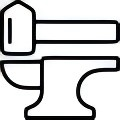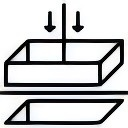
Tool steel is a critical component in the manufacturing and machining industries, recognized for its ability to perform under the rigorous conditions of complex tool applications. Promispecial provides high specification tool steel to meet the high performance and durability requirements in production. This article will delve into the various properties of tool steel, enabling industry experts to understand how to maximize material potential for their specific applications.
Understanding Tool Steel and Its Properties
Definition and Composition of Tool Steel
Tool steel is a specific type of steel formulated for manufacturing tools, such as cutting instruments and dies. It is engineered to provide superior hardness, resistance to deformation, and abrasion resistance. The composition of tool steel typically includes high carbon and alloying elements such as chromium, vanadium, and molybdenum, which contribute to its exceptional physical properties. These elements not only enhance the steel’s hardness but also improve its thermal resistance and overall integrity, making tool steel an optimal choice for demanding tool applications.
Categories of Tool Steel
Tool steel is categorized into various types based on its composition and intended use. These categories include high-speed steel (HSS), cold work tool steel, hot work tool steel, and plastic mold steel. Each category serves a distinct purpose; for instance, HSS is favored for its ability to withstand high temperatures generated during machining processes, while cold work tool steel is ideal for cold-forming applications due to its remarkable hardness. Understanding these categories helps industry specialists select the appropriate type of tool steel, ensuring that the material meets the performance requirements of each specific application.
Key Characteristics of Tool Steel
Hardness
One of the most significant characteristics of tool steel is its hardness, which is essential for maintaining the cutting edge and ensuring long-lasting performance. Hardness is usually measured on the Rockwell scale, where various types of tool steels can achieve hardness levels ranging from 50 to over 67 HRC. High hardness levels are critical for tools that require repeated sharpening operations, as they maintain a sharper edge for extended periods. The heat treatment process, including quenching and tempering, plays a vital role in maximizing the hardness of tool steel, allowing it to meet the strict demands of machining and forming tasks.
Toughness
In addition to hardness, toughness is another critical property of tool steel that affects its performance. Toughness refers to the material’s ability to absorb energy and deform without breaking. Tool steels designed for high toughness are particularly important when used in applications that involve impact or shock loads. The balance between hardness and toughness must be carefully considered, as overly hard tool steel may become brittle and prone to fractures. Therefore, selecting the right kind of tool steel with an appropriate toughness rating can significantly improve the reliability of the tools during challenging operations.
Wear Resistance
Wear resistance is a defining feature of tool steel, enabling tools to withstand extensive use without significant degradation. This property is particularly vital in high-abrasion environments, which might involve contact with hard materials or high-friction conditions. Tool steel’s wear resistance is enhanced through alloying elements such as chromium and vanadium, which contribute to the formation of hard carbides within the steel matrix. This characteristic reduces wear and extends tool life, resulting in cost savings for manufacturers who rely on high-performance tools for their production processes.
Heat Resistance
Heat resistance is an important factor for tools subjected to high-temperature applications. Tool steels with good heat resistance can maintain their properties even when exposed to elevated temperatures, such as those generated during machining or forming processes. This characteristic is crucial for ensuring that tool performance remains stable and effective under thermal stress. High-speed steels, for example, are specifically designed to perform at higher temperatures, allowing for increased cutting speeds and improved productivity. By choosing tool steels with suitable heat resistance for specific applications, manufacturers can achieve enhanced performance and longevity of their tools.
Machinability
Machinability is another characteristic that influences the selection of tool steel. It describes how easily the material can be machined into the desired shape and size while minimizing tool wear. Although tool steels are known for their hardness and durability, some grades are formulated to offer improved machinability without sacrificing strength. The machinability of tool steel can be enhanced through the addition of specific alloying elements, as well as through proper heat treatment processes. For industries dependent on precision machined components, factoring in machinability can lead to increased efficiency in production and reduced costs associated with tooling wear and tear.
In conclusion, understanding the characteristics of tool steel is essential for achieving peak material performance in challenging applications. By focusing on the definitions, categories, and key properties such as hardness, toughness, wear resistance, heat resistance, and machinability, industry experts can effectively select and utilize tool steel in their manufacturing processes. The tool steel products provided by Promispecial, like alloy tool steel and carbon tool steel perfectly meets the above characteristic requirements and can effectively improve product quality in strict environments.
Enhancing Tool Steel Performance
Heat Treatment Processes
Heat treatment is a critical process in optimizing tool steel for various applications, as it alters the microstructure of the material to enhance its performance characteristics. The common heat treatment methods include annealing, quenching, and tempering. Annealing is employed to improve machinability and reduce residual stresses, while quenching hardens the steel by rapidly cooling it in a liquid medium, which transforms the microstructure to martensite. Tempering is conducted afterward to relieve stresses and adjust hardness levels, thereby achieving a balance between hardness and toughness. This precise control over the heat treatment process allows manufacturers to fine-tune the properties of tool steel, ensuring they align with specific performance requirements in challenging applications.
Furthermore, different tool steel grades respond uniquely to heat treatment. High-speed steel (HSS), for instance, requires specific thermal cycles to enhance its high-temperature performance, while cold work tool steel may demand different parameters to maximize wear resistance and toughness. Understanding the unique requirements of various types of tool steel during the heat treatment process helps in delivering materials that meet operational expectations, enabling tools to maintain performance standards over time. As industries demand increasingly sophisticated tool capabilities, refining heat treatment techniques becomes paramount in producing tool steel that meets these evolving needs.
Surface Treatments
Surface treatment processes are another vital component in enhancing the performance of tool steel, as they provide additional protective and functional attributes to the material. Common techniques include nitriding, coating, and surface hardening, each of which influences the wear resistance, friction characteristics, and overall service life of tool steel tools. Nitriding, for example, introduces nitrogen into the surface layer of the steel, resulting in a hardened, wear-resistant surface that can significantly extend tool life by reducing the frequency of replacements. Coatings, such as titanium nitride or chromium, can also improve the tool’s performance by creating a thin, highly durable layer that enhances wear resistance and decreases friction, ultimately leading to more efficient machining operations.
Moreover, the application of surface treatments must be understood in conjunction with the underlying material properties of the tool steel. The effectiveness of surface coatings can be influenced by the base material’s hardness and toughness. For instance, if the underlying tool steel is too brittle, coating it might not yield the desired results, as cracks could propagate from the substrate through to the coating. Therefore, manufacturers must carefully select both the tool steel type and the appropriate surface treatment to maximize overall performance.
Emerging Trends in Tool Steel Technologies
Advancements in Alloy Development
The field of tool steel is continuously evolving, with advancements in alloy development playing a significant role in enhancing material performance and broadening application scopes. These developments often focus on achieving improved properties such as hardness, toughness, and corrosion resistance through the introduction of new alloying elements or the optimization of existing compositions. For instance, the integration of modern elements like cobalt and tungsten in certain tool steel grades has been found to enhance high-temperature hardness and wear resistance, making them suitable for advanced machining processes in aerospace and automotive sectors.
Research into alternative alloying techniques has also gained traction, where a greater understanding of carbide distribution and microstructure evolution enables engineers to design tool steels that exhibit superior performance attributes. This ongoing innovation leads to tool steel variants tailored for specific applications, such as those that can endure extreme conditions or provide greater durability against wear. As industries call for tools that are not only high-performing but also cost-effective, advancements in alloy development are increasingly crucial, allowing for the creation of cutting-edge materials that elevate production capabilities.
Innovative Manufacturing Techniques
The adoption of innovative manufacturing techniques is a cornerstone of modern tool steel production, contributing significantly to the optimization of material properties and ultimately enhancing tool performance. Techniques such as powder metallurgy allow for precise control over the composition and microstructure of tool steel, resulting in materials that are both superior in performance and more efficient in production. Through powder metallurgy, smaller and more uniform particles create a dense matrix, leading to improved mechanical properties and finer microstructures that enhance hardness and toughness.
Additionally, additive manufacturing technologies have begun to gain prominence in tool steel production, offering new possibilities for complex and customized tool designs. This subtractive approach allows for the creation of geometrically intricate tools that would be challenging or impossible to manufacture through traditional machining techniques. As these technologies mature, they promise to revolutionize the accessibility and possibilities of tool steel applications across various industries. Promispecial is at the forefront of utilizing such developments, ensuring they can meet the complex demands of their clients with innovative and tailored tool solutions that harness the full potential of tool steel materials.
Maximizing the Life Span of Tool Steel Tools
Proper Maintenance Practices
Proper maintenance practices are vital to prolonging the life span of tool steel tools. Regular cleaning is paramount to remove chips, dust, and other debris that can lead to corrosion and degradation. Employing rust inhibiting oils or coatings can significantly enhance the corrosion resistance of tool steel, safeguarding it against environmental factors that would otherwise compromise its integrity. Furthermore, operators should be trained in proper handling techniques to minimize accidents or misuse that could lead to premature wear or damage.
Another critical aspect of maintenance is the application of appropriate lubrication during use. High-quality lubricants reduce friction and heat, minimizing wear and preventing overheating during machining operations. Moreover, maintenance schedules should include periodic reconditioning to address any wear patterns before they evolve into significant structural issues. Establishing a routine maintenance protocol not only ensures that the tools operate effectively but also enhances overall operational efficiency in the manufacturing process.
Regular Inspection and Testing
Regular inspection and testing of tool steel tools form an essential part of ensuring their longevity and effectiveness. Visual inspections should be routinely conducted to identify any signs of wear, corrosion, or damage that could impact performance. Anomalies in the cutting edges or surfaces should be addressed immediately through sharpening, which is pivotal in maintaining optimal cutting performance. Additionally, employing non-destructive testing methods allows for the evaluation of internal integrity without compromising the tool.
Moreover, measuring hardness levels and conducting impact tests can provide valuable insights into the condition of the tool steel. These assessments help identify any changes in properties resulting from wear or the heat treatment processes that the tools have undergone. Implementing a systematic inspection and testing regime will ensure that the tools remain within operational parameters, ultimately reducing unexpected failures and enhancing productivity levels.
Reconditioning Methods
Reconditioning methods are essential to restore tool steel tools to their optimal working condition, extending their life and maintaining performance. Sharpening tools is one of the most common reconditioning practices; it not only restores the cutting edge but also enhances the efficiency of machining operations. Various techniques, such as grinding or honing, can be employed depending on the specific tool design and wear characteristics. It is crucial to utilize appropriate methods tailored to the type of tool steel to avoid excessive removal of material that could alter the tools’ properties.
Additionally, heat treatment can be revisited as a reconditioning approach. Tools with diminished hardness can undergo processes like re-quenching to restore their original properties effectively. Any signs of surface damage can also be addressed through surface treatment techniques such as hard coating or nitriding, which fortify the material’s surface against wear. By utilizing these reconditioning methods wisely, manufacturers can maximize tool steel usage, ensuring consistent performance while reducing the need for frequent replacements, considerably benefiting businesses.
Promispecial can ensure the importance of raw materials while providing a high performance environment that supports tool lifespan and performance. Continuously improving heat treatment and surface strengthening processes, coupled with diligent and professional maintenance, enable the material potential of tool steel to be fully developed and utilized, ultimately achieving success in the rigorous manufacturing and processing fields























